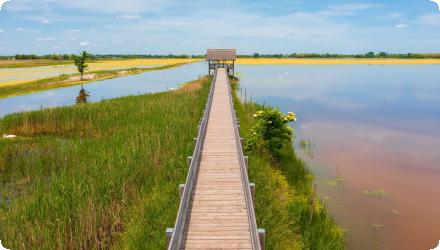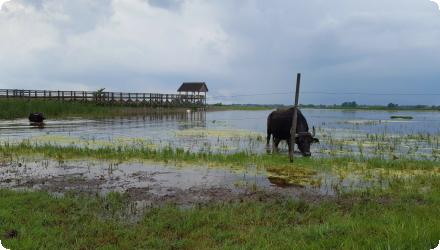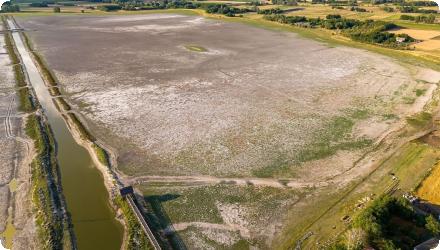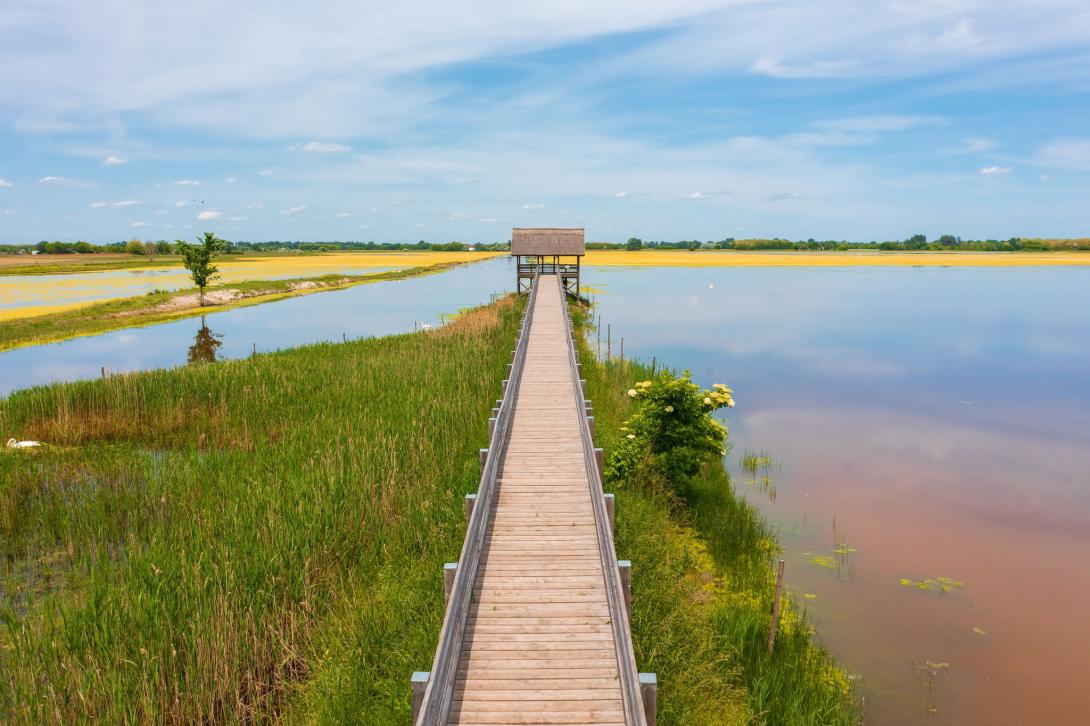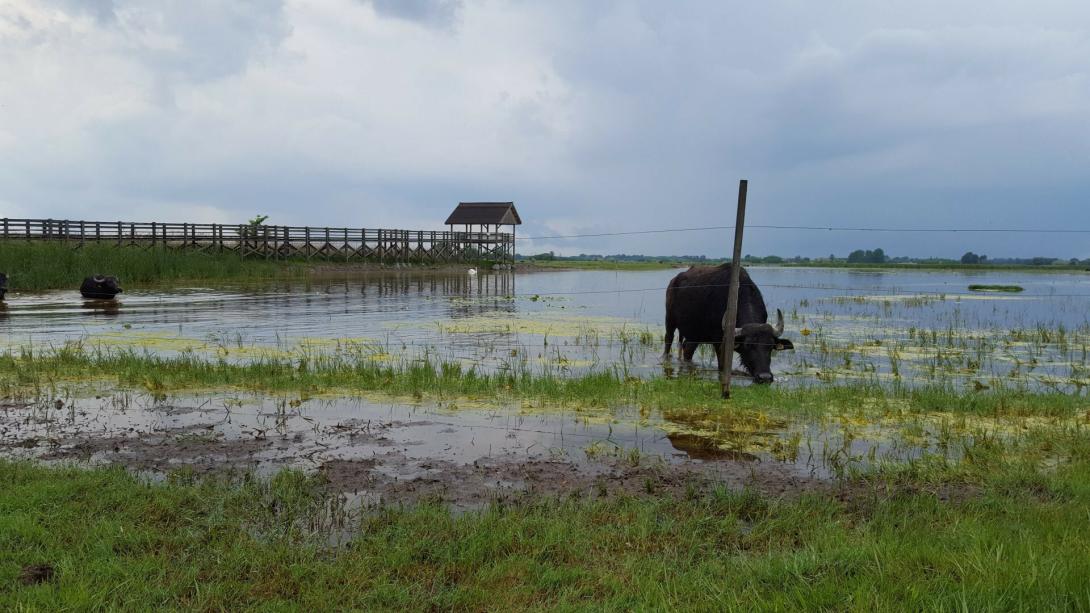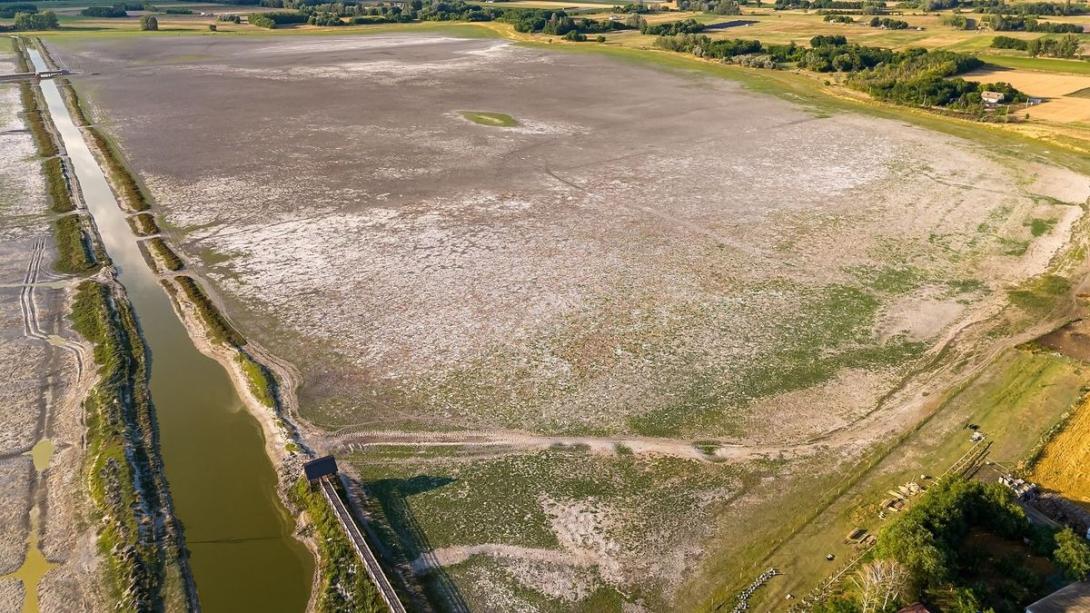Last update
2025
Summary
The Nagyszéksós-tó project aimed to safeguard the natural and recreational functions of the protected lake area by improving retention of 1.2 million m³ of water from excess periods and supplying surplus water from the nearby village’s treatment plant, with extra polishing in a newly created wetland. Other objectives included enhancing groundwater recharge, restoring drainage capacity to avoid prolonged waterlogging of farmland, and providing Mórahalom with improved recreation, cultural and educational opportunities.
Since completion, the site has become a key habitat, supported by buffalo grazing for vegetation management and seasonal hydrological cycles typical of saline lakes. In recent years, summer drying has recurred, seen by conservationists as a natural phenomenon, though it poses challenges for tourism. A major eco-tourism development started in 2024–2025, led by the Kiskunság National Park Directorate and Mórahalom municipality, will deliver a new visitor centre, thematic trails, birdwatching towers and educational facilities, scheduled to open in 2026, aiming to balance habitat protection with sustainable public access.
Since completion, the site has become a key habitat, supported by buffalo grazing for vegetation management and seasonal hydrological cycles typical of saline lakes. In recent years, summer drying has recurred, seen by conservationists as a natural phenomenon, though it poses challenges for tourism. A major eco-tourism development started in 2024–2025, led by the Kiskunság National Park Directorate and Mórahalom municipality, will deliver a new visitor centre, thematic trails, birdwatching towers and educational facilities, scheduled to open in 2026, aiming to balance habitat protection with sustainable public access.
Position
Latitude
46.22
Longitude
19.95
Project
NWRM
National Id
Hungary_02
Implementation Status
Contact
Gábor Ungvári
RBD code
HU1000
Transboundary
0
Photo gallery
Location of the project
The Nagyszéksós Lake protected area is located on the southern edge of Mórahalom, Csongrád-Csanád County, Hungary, close to the Röszke–Mórahalom road (route 5511) and the Serbian border, within the Kiskunság National Park’s administrative area.
NUTS Code
HU33 - Dél-Alföld
Project's objectives
Improve water retention – Store 1.2 million m³ of water from excess periods in the Nagyszéksós Lake basin.
Supplement water supply – Deliver surplus treated water from Mórahalom’s wastewater treatment plant to the lake
Enhance groundwater recharge – Increase infiltration to support shallow aquifers.
Restore drainage capacity – Prevent prolonged waterlogging of adjacent agricultural land.
Safeguard and enhance natural values – Maintain biodiversity of the saline lake and surrounding habitats.
Strengthen recreational, cultural, and educational functions – Improve facilities and opportunities for the local community of Mórahalom.
Supplement water supply – Deliver surplus treated water from Mórahalom’s wastewater treatment plant to the lake
Enhance groundwater recharge – Increase infiltration to support shallow aquifers.
Restore drainage capacity – Prevent prolonged waterlogging of adjacent agricultural land.
Safeguard and enhance natural values – Maintain biodiversity of the saline lake and surrounding habitats.
Strengthen recreational, cultural, and educational functions – Improve facilities and opportunities for the local community of Mórahalom.
Involved Partners
| Authority type | Authority name | Role | Comments |
|---|---|---|---|
Climate zone
warm temperate dry
Temperature
11
Precipitation
525
Runoff
2,35
Runoff coefficient
1,13619995117188
Runoff range
600 - 750 mm
Elevation range
86
Vegetation class
It is a wetland area surrounded by crop production agricultural lands. Predominantly saline meadow and wetland vegetation, managed partly through buffalo grazing to maintain open, herbaceous habitats and prevent reed overgrowth.
Water bodies: Ecological Status
Unknown
Water bodies: Chemical Status
Unknown
Project scale
Micro
Project scale specification
Focused on a single protected site (Nagyszéksós Lake) and its immediate surroundings in Mórahalom, with local hydrological works, habitat management, and eco-tourism infrastructure.
Performance timescale
Immediate
Project area
75 ha
Area subject to Land use change or Management/Practice change (ha)
9
Lifespan
30
Design capacity description
1.2 million cubic m (m3)
The size of the area is constrained, bigger volume retention would threaten agricultural lands
The main drainage channel of the district's drainage network passes by the lake. (The lake itself the area that reamined an drained)
Total cost
unkown
Costs total information
Initial rehabilitation project (DAOP 5.2.1/D, mid-2000s) – exact total cost is not published
Eco-tourism development project (KEHOP Plusz, 2024-2026) : 1.4 billion HUF (~ €3.6 million) total budget
Eco-tourism development project (KEHOP Plusz, 2024-2026) : 1.4 billion HUF (~ €3.6 million) total budget
Costs investment
747095,25
Costs investment information
New water supply chanel, creation of wetland, reconstruction work inside the lake, reconstruction of drainage channels.
Inflation adjusted price from HUF 2009
Inflation adjusted price from HUF 2009
Costs operation maintenance
1666,66662597656
Costs operation maintenance information
This is the maintenance cost of the channels. Additonal cost will emerge in case of severe water shortage (reference to the water depth), the pumping of treated water to the constructed wetland to start supply the lake will start. It will have a cc 15€/day cost.
Financing authorities
Type of funding
EU-funds: Cohesion and regional development funds
Comments
DAOP 5.2.1/D - Komplex vízvisszatartási akcióprogram a Nagyszéksós-tó vízrendszerében
Type of funding
National funds
Type of funding
Local funds
Compensations
0
Policy context
It is a lake-wetland with big shallow areas, the water level drops left these areas dry out frequently. The NWRM will mitigate the changes of water level. WFD pressure 4.1.2; 4.3.1 2.2??
Land ownership
The Nagyszéksós Lake protected area is publicly owned and managed by the Kiskunság National Park Directorate.
Community involvment
No
Design consultation activity
| Activity stage | Name | Key issues | Comments |
|---|
Policy target
| Target purpose |
|---|
|
Increase Water Storage
|
|
Improved Biodiversity
|
|
Peak-flow reduction
|
|
Groundwater Recharge
|
|
Pollutants Removal
|
|
Oher Societal Benefits
|
Policy pressure
| Pressure directive | Relevant pressure |
|---|
Policy impact
| Impact directive | Relevant impact |
|---|
Requirement directive
| Requirement directive | Specification |
|---|
Contractual arrangements
0
| Arrangement type | Responsibility | Role | Name | Comments |
|---|---|---|---|---|
|
The parties will prepare a plan to specify the operation details after the experiences of the first years in operation.
|
Part of wider plan
0
Wider plan type
| Wider plan type | Wider plan focus | Name | Comments |
|---|
Monitoring is carried out by the Kiskunság National Park Directorate and environmental authorities, focusing on the ecological status of the lake, bird populations, and vegetation changes, in line with national conservation and Natura 2000 obligations.
Ornithological monitoring (breeding and migratory bird counts, species presence, nesting success), vegetation surveys (extent and composition of saline meadow and reed habitats), and hydrological observations (visual assessment of water level, presence/absence of surface water, seasonal drying). Scientific studies have also assessed water chemistry (salinity, conductivity, pH, major ions, phosphate) to understand hydrological and nutrient dynamics. These data support both habitat management (e.g. timing and intensity of grazing) and hydrological regulation (e.g. operation of channels) to balance conservation goals with recreational use.
Maintenance
Maintenance is led by the Kiskunság National Park Directorate, mainly through buffalo grazing to limit reed growth, plus occasional invasive removal and upkeep of inlet/outlet structures.
Catchment outlet
1666,66662597656
There are avoided costs. According to the predictions the upgraded situation will decrease the total maintenace costs that emerged previously at the two organisations (water directorate, national park)
Improved recreational, cultural, and educational opportunities for Mórahalom residents and visitors. Ongoing eco-tourism development (2024–2026) will add a visitor centre, themed trails, and birdwatching towers, aiming to increase sustainable tourism revenue. Expected boost to hospitality, services, and local employment through tourism infrastructure.
Buffalo grazing is integrated into local agricultural activity, with potential income from livestock products.
Improved recreational, cultural, and educational opportunities for Mórahalom residents and visitors. Ongoing eco-tourism development (2024–2026) will add a visitor centre, themed trails, and birdwatching towers, aiming to increase sustainable tourism revenue. Expected boost to hospitality, services, and local employment through tourism infrastructure.
Buffalo grazing is integrated into local agricultural activity, with potential income from livestock products.
There is no economic assessment of the miscallenous benefits. These could come from recreational activities, nutrient load mitigation and habitat services.
Information on retained water
The rehabilitation works increased the lake’s capacity to store 1.2 million m³ of excess water
Information on Restoring hydraulic connections
New inlet from Mórahalom’s wastewater treatment plant and a polishing wetland created; artificial channels (Széksóstói main canal) also influence hydrology
Water quality overall improvements
Positive impact-WQ improvement
Information on Water quality overall improvements
There is no quantitative inforamtion to measure the changes. Water chemistry studies recorded high salinity and alkalinity (Na, K, Mg, Cl, HCO₃⁻, CO₃²⁻), typical of saline lakes; phosphate presence linked to external inputs (including a point source found in reeds)
Soil quality overall soil improvements
N/A info
1
The eutrophication process that threatened the lake was changed, the water lily (Nympheaetum albae) appeared again in the lake. The site functions as a key breeding, migratory, and feeding area for birds; increase in habitat heterogeneity noted.
In recent years, complete summer drying has occurred, potentially reducing aquatic habitat availability, though conservationists note it is a natural seasonal cycle for saline lakes.
In recent years, complete summer drying has occurred, potentially reducing aquatic habitat availability, though conservationists note it is a natural seasonal cycle for saline lakes.
Ecosystem impact climate regulation
No information available
Ecosystem provisioning services
1
Information on Ecosystem provisioning services
The biomass of the lake now serves as feedstock for the buffalos. A recently finished, paralel ecology pilot-project applied water buffalos (Bubalus bubalus) to repel invasive species from the area. The first results of the program are positive.
Key lessons
The project required the compromise of the water directorate and the national park how they manage their disparate interests of water levels in the lake facing the unpredictability of precipitation events. The further expansion of such a scheme in the area would have public, environmental and private gains as well, but the parties at the moment see no means how to harmonize conflicting interests if not only public, but privately owned lands would be involved as well.
One key lesson from the Nagyszéksós Lake project is that combining hydrological restoration with active habitat management can deliver both ecological and socio-economic benefits. The integration of buffalo grazing into the management plan proved effective in maintaining open saline meadows, controlling reed encroachment, and supporting biodiversity.
Another important point is the need to align ecological processes with human expectations. The natural seasonal drying of a saline lake is ecologically beneficial, but it can clash with tourism objectives that expect a permanent water body. This highlights the value of clear communication with stakeholders and adaptive management that respects natural cycles while providing visitor experiences.
The project also shows the benefits of long-term partnerships between local authorities, water management agencies, and conservation bodies. Coordinated actions between the Kiskunság National Park Directorate, the municipality, and technical agencies enabled both infrastructure development and habitat conservation.
Finally, the recent eco-tourism investment demonstrates that restoration projects can evolve over time, adding new functions while maintaining ecological goals. However, these expansions should be carefully planned to avoid compromising the natural dynamics that underpin the site’s conservation value.
One key lesson from the Nagyszéksós Lake project is that combining hydrological restoration with active habitat management can deliver both ecological and socio-economic benefits. The integration of buffalo grazing into the management plan proved effective in maintaining open saline meadows, controlling reed encroachment, and supporting biodiversity.
Another important point is the need to align ecological processes with human expectations. The natural seasonal drying of a saline lake is ecologically beneficial, but it can clash with tourism objectives that expect a permanent water body. This highlights the value of clear communication with stakeholders and adaptive management that respects natural cycles while providing visitor experiences.
The project also shows the benefits of long-term partnerships between local authorities, water management agencies, and conservation bodies. Coordinated actions between the Kiskunság National Park Directorate, the municipality, and technical agencies enabled both infrastructure development and habitat conservation.
Finally, the recent eco-tourism investment demonstrates that restoration projects can evolve over time, adding new functions while maintaining ecological goals. However, these expansions should be carefully planned to avoid compromising the natural dynamics that underpin the site’s conservation value.
Success factor(s)
| Success factor type | Success factor role | Comments | Order |
|---|---|---|---|
|
Existing institutional framework
|
main factor
|
<p>The area is state property</p>
|
1
|
|
Successful coordination between authorities
|
main factor
|
2
|
|
|
Financing possibilities
|
main factor
|
3
|
|
|
Attitude of relevant stakeholders
|
secondary factor
|
<p>The local government of the nearby village was supportive. The village has direct benefit from the project. There is an improvement in recreational facilities</p>
|
4
|
Driver
| Driver type | Driver role | Comments | Order |
|---|---|---|---|
|
Balancing different objectives
|
main driver
|
The obligation of the water authority (to provide safety against flood or water logging threats are in contradiction with the environmental management objectives of the national park. Because the lake serve as a buffer for storage of the surplus water. The applied solution is a way forward from this situation, but without the financial sources of the operative program no sources would be attained.
|
1
|
|
Availability of subsidies
|
secondary driver
|
2
|
Transferability
The measure is transferable to other small saline or seasonal wetlands where hydrological restoration and grazing can sustain biodiversity. Success depends on respecting natural water level fluctuations, securing long-term stakeholder cooperation, and balancing tourism with conservation. Care is needed to avoid altering salinity or drying cycles, and to ensure infrastructure does not harm habitat integrity.
English
